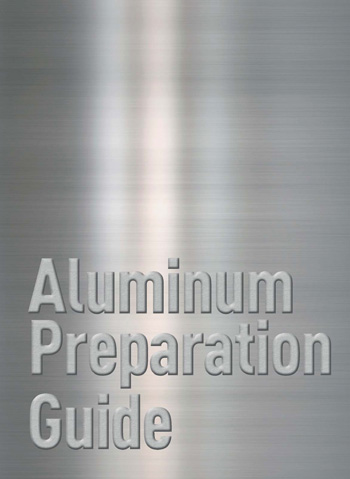 Ever since Ford Motor Company announced that the 2015 F-150 pickup was going to be made almost entirely of aluminum, and that this vehicle would be hitting showrooms by fall of 2014, collision repairers have been assessing whether they’re adequately equipped and trained to handle such repairs.
Ever since Ford Motor Company announced that the 2015 F-150 pickup was going to be made almost entirely of aluminum, and that this vehicle would be hitting showrooms by fall of 2014, collision repairers have been assessing whether they’re adequately equipped and trained to handle such repairs.
Aluminum is such a different animal than steel. It has no memory like steel does. Its optimal working temperature is 400 to 570 degrees Fahrenheit. It requires its own dedicated set of tools to avoid cross contamination with steel. There are other differences too, but the point is that most repairers will have to add to their equipment arsenal to properly and safely repair aluminum vehicles…because the use of aluminum in vehicles is only going to grow in the coming years.
“This the first time I’ve seen it in my entire career where the whole industry is having to retool,” says Richard Perry, global repair product manager for Chief Automotive Technologies. “When I started, every shop had to have a MIG welder to weld steels. Now, steels have advanced or, in some cases, gone away, and you need squeeze-type resistance and aluminum welders. So shops have had to retool, and with that, rethink how to repair the vehicle.”
According to Perry, aluminum is tricky to weld because you need to maintain a constant temperature to create the best weld. What helps with that is a push-pull feature found on welders from Elektron, one of the brands under the Vehicle Services Group which Chief is a part of. This can eliminate the wire from “bird-nesting” inside of the welder, which would create inconsistent welds.
“The push-pull gun also has a thumb switch where you can manually control the wire,” says Perry. “Let’s say you need a hot start, and as you’re welding, the material gets really hot and starts to fall out too much and you need to cool it down, you can use the switch to slow the current and wire speed to make a cooler weld to finish.”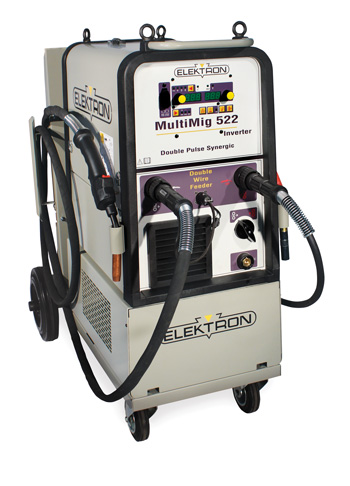
In addition to the Chief frame racks, LaserLock live mapping system and Elektron spot welders that are already available to Ford dealers through the Rotunda Dealer Equipment program, Ford has approved the following F-150 special tools:
- Chief Structural Holding with F-150 Kit – Complete
- Chief F-150 Holding Kit
- Chief Deluxe Chain and Clamping Package with Rolling Cart
- Chief Collet Style Target Attachment Set for Non-Ferrous Vehicle Openings
- Elektron MultiMig 511 Welder with Standard Torch
- Elektron MultiMig 511 Welder with Push-Pull Torch
- Elektron MultiMig 522 Dual Torch Welder Complete with Standard and Push-Pull Torch
- Elektron MultiTool Aluminum Dent Repair Station
Ron Olsson, president of Pro Spot International, also expressed amazement at the rapid change going on in the industry, saying it’s something he hasn’t seen in his 25 or so years in the business.
“We used to try to knock the OEMs’ doors down trying to get recognition and approval for repair procedures with our products, but now these new metals – aluminum, boron, ultra high strength steel – demand more attention and training and the OEMs are extremely concerned that technicians are repairing these vehicles correctly, which I think is helping our industry move one level up.”
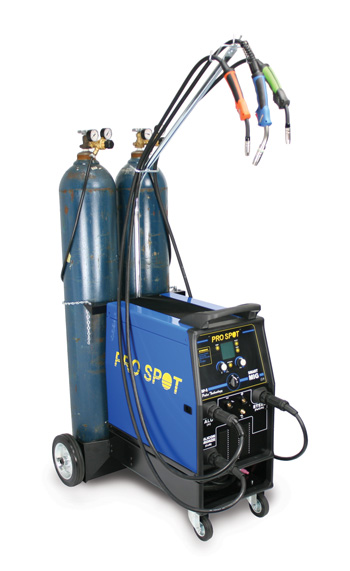
Pro Spot has a whole array of equipment specifically designed for aluminum repair, including the SP Series of aluminum pulse MIG welders (approved by Ford for the F-150), aluminum weld stations, PR5 self-piercing rivet gun and fume extractor.
“Our aluminum weld station contains all the tools necessary to repair dents in aluminum,” says Olsson. “It has an AL5 capacity discharge welder than can weld on aluminum studs into dents in panels and also pulling tools to pull the dents out. It also contains a heating element where you can heat aluminum a little as you pull it and measure and maintain the correct temperature with a laser-based temperature gauge. It also has a utility panel with 110 and 220 volts and a compressed air outlet so you don’t have cables and hoses everywhere. Finally, it has a foldable work table so you can set it up anywhere on the shop floor and it becomes a workstation with a work bench. And it’s affordable, too.”
The self-piercing rivet gun, Olsson says, is critical in that most aluminum will be repaired by rivets instead of spot welds. In fact, Ford requires self-piercing rivets and structural adhesive for the F-150. The PR5 is battery-operated, portable and lightweight.
Pro Spot’s fume extractor, designed to take care of poisonous fumes from welding aluminum and other metals, is available in a portable model or one built in to the aluminum
weld station.
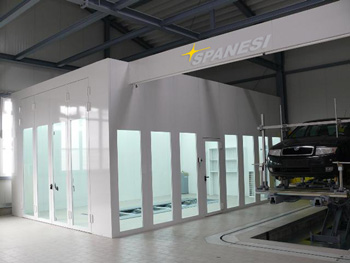 Speaking of heat, Induction Innovations’ line of induction heaters can be used to safely heat aluminum and other metals, minimizing the Heat Affect Zone (HAZ) to the repair and not nearby parts.
Speaking of heat, Induction Innovations’ line of induction heaters can be used to safely heat aluminum and other metals, minimizing the Heat Affect Zone (HAZ) to the repair and not nearby parts.
“Induction heat is ideal for aluminum because it gives the user greater control of the heat than what they would have with torches, heat guns or infrared lamps,” says Steve Gough of Induction Innovations.
Spanesi Americas says it has a “complete solution” for all aluminum tools and equipment: clean containment rooms, MIG/MAG welders, riveters, dent repair, stud welders, dust extractors, fume extractors, personal protection, measuring, fixturing, lifting and pulling equipment.
“Aluminum containment first is a priority for protecting aluminum vehicles from exposure to steel filings, or dust which can cause galvanic corrosion,” says Tim Morgan, managing director of Spanesi Americas. “Also, the steel and aluminum grindings need to be separated to protect against an explosion, because if they mix together they could create a volatile situation. So what contacts the aluminum vehicle, including hand tools, needs to be separate from those used on a steel vehicle.”
Spanesi Americas is still in discussions with Ford on approval of its equipment, but it has already been approved by Jaguar/Land Rover for their aluminum vehicles.
Morgan advises repairers to research all makes and models of vehicles they will repair and make the purchase of equipment with that in mind, not narrowing themselves to a particular model vehicle.
“Aluminum repairs will increase as the need for lighter vehicles striving to meet fuel economy demands continues,” he says.
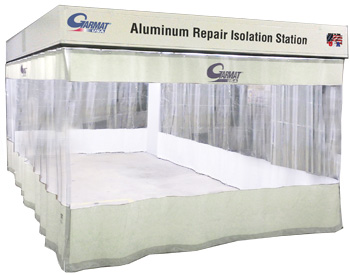 Garmat USA has a full line of another type of equipment essential to aluminum repair – isolation stations. They start with entry-level systems such as curtain isolation up to a fully enclosed pressurized unit that provides the necessary filtration for grinding. In addition to their standard models, they also offer custom aluminum repair clean room designs for a more enhanced aluminum repair environment.
Garmat USA has a full line of another type of equipment essential to aluminum repair – isolation stations. They start with entry-level systems such as curtain isolation up to a fully enclosed pressurized unit that provides the necessary filtration for grinding. In addition to their standard models, they also offer custom aluminum repair clean room designs for a more enhanced aluminum repair environment.
“The AlumaSAFE 50 provides the needed isolation for welding or other aluminum repair processes,” says Debbie Teter, marketing manager for Garmat USA. “The AlumaSAFE 100 and AlumaSAFE 500 expands on the idea of isolation by adding a fan unit that allows both of these models to be used for grinding operations as well. The AlumaSAFE 100 is a non-pressurized system featuring recirculating crossdraft airflow, Fortex spark arrestor panels and three stages of high-efficiency filtration including HEPA. The AlumaSAFE 500 expands on the design further by pressurizing the unit and adding a fully lit ceiling for an improved working area.”
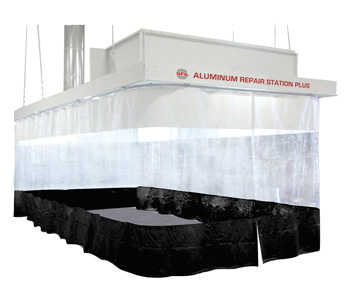 Global Finishing Solutions also specializes in clean areas to protect aluminum vehicles and parts during the repair process. Their Isolation Station is a basic curtain system in pre-determined sizes for easy ordering and installation. Their Aluminum Repair Station has a lighted, full ceiling for added protection and lighting for the technician. The Aluminum Repair Station Plus adds the flexibility of a paint workstation so the vehicle and/or parts can be primed and sealed prior to exiting the aluminum-safe clean area. This station can also be used for additional painting needs when not being used for aluminum repair.
Global Finishing Solutions also specializes in clean areas to protect aluminum vehicles and parts during the repair process. Their Isolation Station is a basic curtain system in pre-determined sizes for easy ordering and installation. Their Aluminum Repair Station has a lighted, full ceiling for added protection and lighting for the technician. The Aluminum Repair Station Plus adds the flexibility of a paint workstation so the vehicle and/or parts can be primed and sealed prior to exiting the aluminum-safe clean area. This station can also be used for additional painting needs when not being used for aluminum repair.
“A major concern of many of the collision centers we’ve had discussions with is losing a stall to aluminum repair until the volume of aluminum vehicles on the road expands more,” says Brandon Lowder, vice president of refinish, Global Finishing Solutions. “By adding the Aluminum Repair Station Plus, the collision center meets the needs of a clean area for aluminum repair and gains the flexibility of additional painting capabilities.”
All of GFS’s aluminum repair products are included by Ford for repair of the F-150.
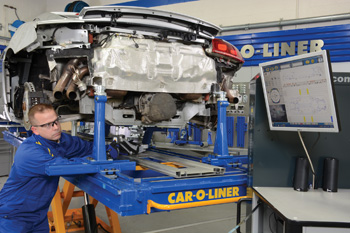 Car-O-Liner also bills itself as a “total solution” for aluminum repairs, with an EVO system with adapters and fixturing, bench measuring, induction heat systems, aluminum carts and welders.
Car-O-Liner also bills itself as a “total solution” for aluminum repairs, with an EVO system with adapters and fixturing, bench measuring, induction heat systems, aluminum carts and welders.
“The aluminum cart and some of the MIG welders that are set up for the programs are configured for aluminum, but they’re also configurable for steel as well so we have that flexibility for all our products,” said Jeff Kern, president of Car-O-Liner.
Car-O-Liner’s equipment is approved by Ford and a number of other OEMs. Specifically, the CMI3000II MIG/MAG Pulse Welder, AUTOMIG 273i Pulse Boost MIG Welder, the truck clamping system and EVO universal anchoring system, and the mobile Aluminum Workstation were added to the F-150 program in March.
“One of the things we try to do at Car-O-Liner is work on our OEM and certified approvals,” said Kern. “Shop owners often become very frustrated because the OEMs have a certain recommendation for a welder, for example, and what we try to do is provide aluminum certification approvals for all disciplines so that ultimately we can save the costs for the shop owner if welders are approved for all manufacturers.”
Added Doug Bortz, “One of our welders has been approved for a number of years, and it’s very specific to the structural as well as cosmetic repair. The newer requirements for the Ford Rotunda Program have been primarily from a different standpoint because they don’t have any structural rails that are aluminum. But I understand that the structure of the aluminum is also considered a structural integral part. We’re not new to the aluminum repair program, and I think that’s a big emphasis.”
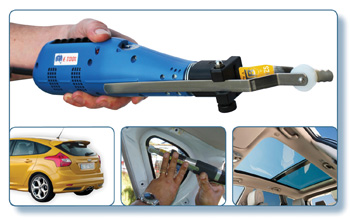 Repairers may not think the choice of glass removal tool is critical to aluminum repair, but they need to think again. Aluminum is a soft material, and BTB’s tools have safety edge blades designed specifically for cutting against softer materials like aluminum and carbon fiber. Their “V” blade cutting edge is suspended away from the blade surface that contacts the aluminum panel, so it can’t scratch or dig into the soft surface. BTB’s WK6 “winged” pinchweld trimming blades are also designed for aluminum vehicles.
Repairers may not think the choice of glass removal tool is critical to aluminum repair, but they need to think again. Aluminum is a soft material, and BTB’s tools have safety edge blades designed specifically for cutting against softer materials like aluminum and carbon fiber. Their “V” blade cutting edge is suspended away from the blade surface that contacts the aluminum panel, so it can’t scratch or dig into the soft surface. BTB’s WK6 “winged” pinchweld trimming blades are also designed for aluminum vehicles.
“Their radius cutting edge ensures that it not only eliminates scratching the paint, but also won’t dig into the aluminum panel,” said Adam Smith, export marketing manager for BTB Tools. “Technicians are aware it can be difficult to avoid scratching with standard trimming blades, long knives and snap-off knives, as they have a razor blade style cutting face and sharp pointed corners hugging the aluminum panel and paintwork.”
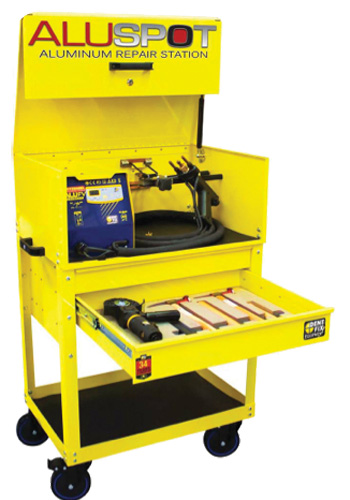 Dent Fix Equipment has been offering the Ford-approved Aluspot aluminum dent repair station to the collision repair industry since 2006. It consists of a lockable cart for tool isolation, a 110-volt capacitor discharge welder to fuse an aluminum stud on the panel, a complete set of hammers and dollies, a heat gun and four different pulling devices for light to heavy pulls.
Dent Fix Equipment has been offering the Ford-approved Aluspot aluminum dent repair station to the collision repair industry since 2006. It consists of a lockable cart for tool isolation, a 110-volt capacitor discharge welder to fuse an aluminum stud on the panel, a complete set of hammers and dollies, a heat gun and four different pulling devices for light to heavy pulls.
“The lockable cart has a scissor-top lid and three tool drawers to totally isolate and lock the tools away when not in use. Tool migration through the shop and possible contamination from dust are virtually eliminated,” said Erik Spitznagel of Dent Fix Equipment. “Isolation of the work area and then of the tools is one of the most significant aspects of aluminum panel repair in order to prevent galvanic corrosion. The complete set of tools , hammers and dollies, nylon shaping tools and inline paint remover tool distinguish us further. Second, our weld gun has the ground located at the welding tip. There is no need to attach separate ground cables. This ensures that the tech grinds away the least amount of paint, and subsequently there is less painting and less blending.
“We also are the only ones to offer our quick-release pulling fingers, which eliminates the need for time-consuming twisting on and off the eyelets to pull. The time it takes to do that is better spent repairing the vehicle. Finally, we are the least expensive but most comprehensive and easy-to-use unit on the market.”
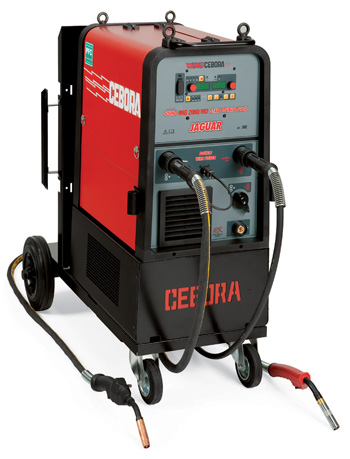 Cebotech USA has been offering equipment for aluminum repair for at least the last 10 years. Their product line includes a pulse MIG welder, two double pulse MIG welders, an aluminum stud welder for dent pulling, a plasma cutter, an aluminum work station and now also a self-piercing rivet gun. They also have two new products coming out within the next year that are being specifically developed for aluminum repair. A couple of their MIG welders, an aluminum stud welder and a plasma cutter are approved by Ford.
Cebotech USA has been offering equipment for aluminum repair for at least the last 10 years. Their product line includes a pulse MIG welder, two double pulse MIG welders, an aluminum stud welder for dent pulling, a plasma cutter, an aluminum work station and now also a self-piercing rivet gun. They also have two new products coming out within the next year that are being specifically developed for aluminum repair. A couple of their MIG welders, an aluminum stud welder and a plasma cutter are approved by Ford.
“These welders and cutters were developed for automotive repair,” says Bill Berman, president, Cebotech USA. “There are other welder suppliers that just offer an existing industrial unit and want the tech at the body shop to use them to repair a vehicle. A welder developed for collision repair is fine-tuned to the needs of the tech. The power, the size of the welding guns, the software and arc characteristics are meant for collision repair.
“Under the best of circumstances, aluminum welding is very demanding. All the factors that are required to produce a good aluminum weld need to be present. Equipment specifically designed to facilitate aluminum welding can go a long way to making aluminum welding much easier. It’s important for a shop to invest in the right equipment for aluminum because it will make the job easier and better. The same goes to all the other peripheral tools and equipment required to repair an aluminum body car or pickup truck.”
On the dust extraction end, Island Clean Air’s Ron Peters states that Ford requires two collection machines: one machine will attach to the sander and source capture larger filings from the sander. This machine will draw large aluminum dust into a hose and the dust will go through water at the other end. This is the wet mix dust capture. The second machine will be a portable dust collector used to capture all the dust that escapes from the sander into the air. This machine will require an enclosed room so that the aluminum dust does not get a chance to mix with steel dust. When steel dust mixes with aluminum dust, it chemically reacts and could ignite and explode.
“Our Duster 3000 Downdraft is perfect for this application and will require curtains (such as Goff’s Curtain Walls),” says Ron Peters of Island Clean Air. “And curtains will be allowed, according to Ford.”
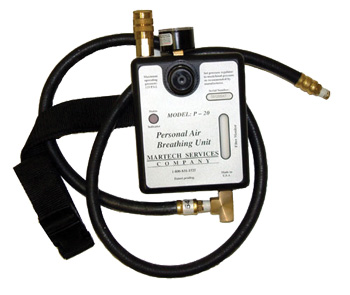 Tom Wright of Martech Services says that even air breathing systems will play a role in aluminum repair.
Tom Wright of Martech Services says that even air breathing systems will play a role in aluminum repair.
“When a person welds aluminum, the need for an air-supplied respirator may be required,” says Wright. “When you weld aluminum, the gases given off during this process are dangerous to our health. In factories where workers weld aluminum parts over and over again, they usually have a system in place to evacuate the gases from the work station. However, if any welding would need to be performed on a vehicle, there would not be this equipment in place, so the use of an air-supplied welding hood or mask would be necessary.”
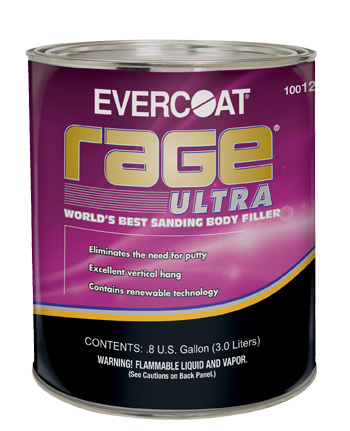 Fillers, Putties and Sanding
Fillers, Putties and Sanding
When thinking of aluminum repair, repairers tend to focus on welders, dent tool stations, aluminum rooms and fume extractors. Not often mentioned are fillers and putties, but these actually can be optimized for aluminum as well. Take, for example, Evercoat’s Rage Ultra and Metal Glaze Ultra.
“We built these with aluminum in mind because of their easy sanding,” says Carl Seaboldt, senior product manager at Evercoat. “We know aluminum is softer than steel, and people have a tendency to chase dents across aluminum hoods because of the different hardness. But our new fillers and putties allow them to keep the dent where it is and not worry about it moving.”
Seaboldt also says that, with the eco resin they’ve added, the products produce a better featheredge on aluminum than traditional body fillers.
“We have enhanced adhesion to aluminum, which right now in the market will be a great thing because repairers won’t have to worry about ‘shadowing’ their repair or seeing rings around the repair because of the featheredge.”
Speaking of sanding, Motor Guard’s new line of “Rigid” sanding blocks work equally well with steel or aluminum. The advantage with aluminum is that these blocks retain their flat rigid profile, but have just the right amount of flex for slight character lines.
“It’s critical to keep these tools in your aluminum repair station and not co-mingle them with your sheet metal tools,” adds Motor Guard’s David Barleen. “The aluminum will react to any ferrous dust and oxidize, destroying the metal.”
Ford F-150 Equipment Requirements to Become a Ford Certified Shop
- 220-volt pulse MIG welder dedicated for aluminum
- Separate hand/power tool kit dedicated for aluminum
- Dedicated aluminum dent extraction system containing an aluminum stud welder, heat gun, pyrometer, aluminum hammers and dent extraction systems
- Dedicated aluminum dust extraction system with wet mix technology – system can be portable or a central installed system
- Have a work separation system that isolates aluminum vehicles from vehicles undergoing steel repairs – separation can be a separate room or curtain system
- Have a specialized aluminum SPR (self-piercing rivet) gun approved by Ford Paint and Body Technical Center
- Optional equipment: a select number of qualifying frame alignment accessories are available for Chief and Car-O-Liner frame systems
- Optional equipment: Fume extraction systems can be permanently mounted or portable













